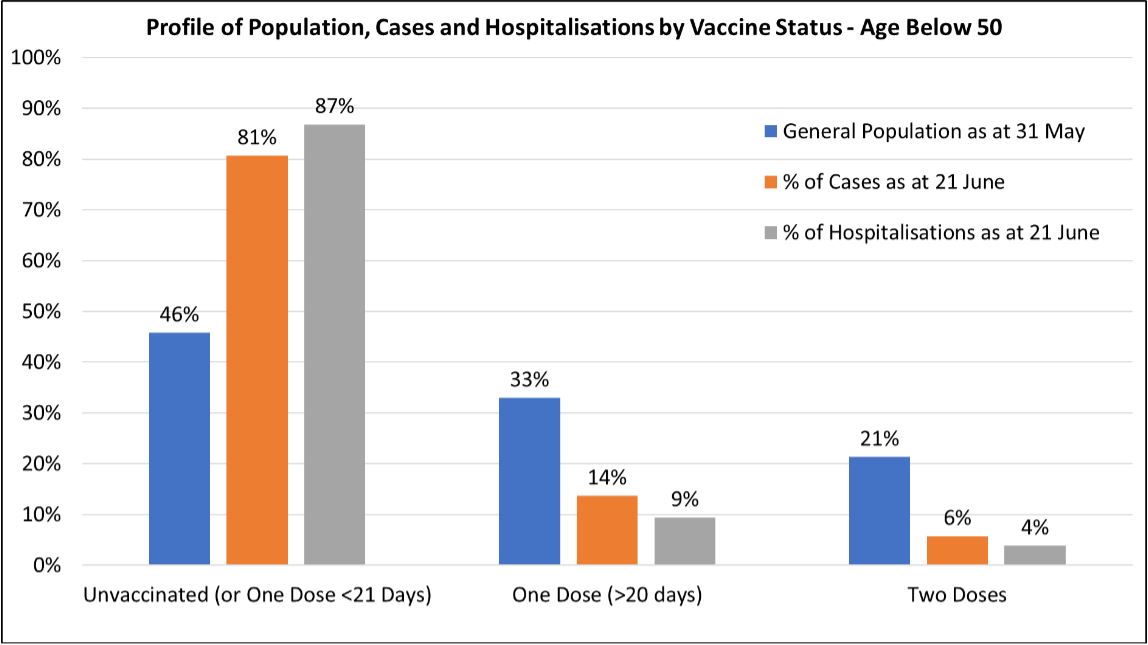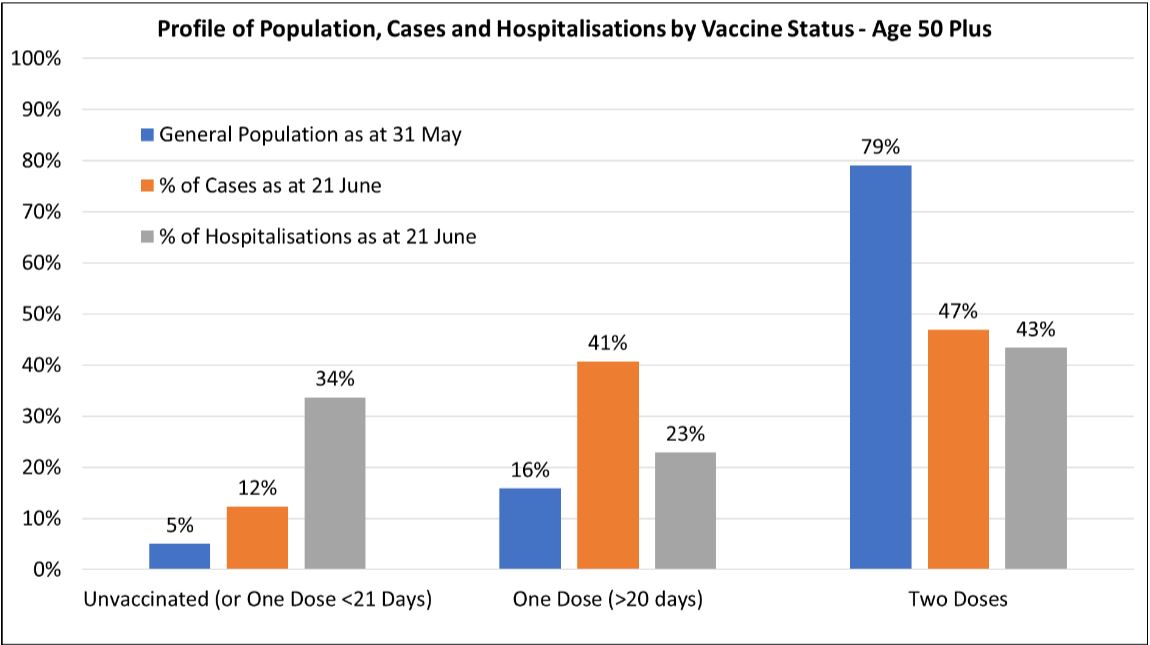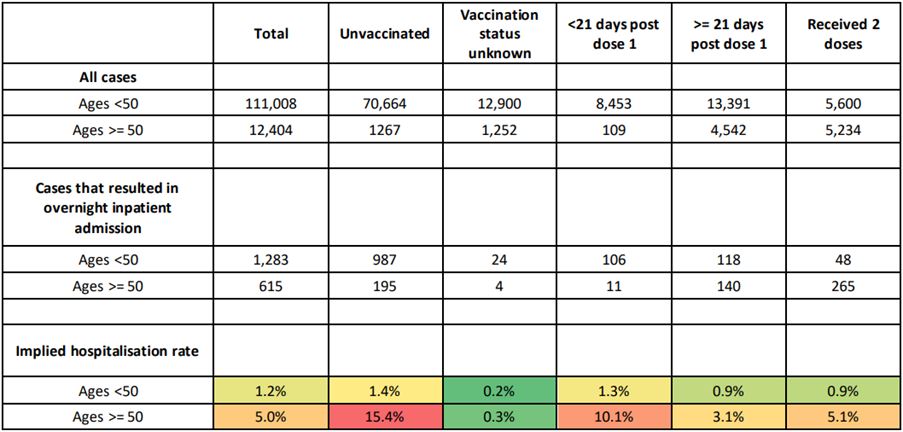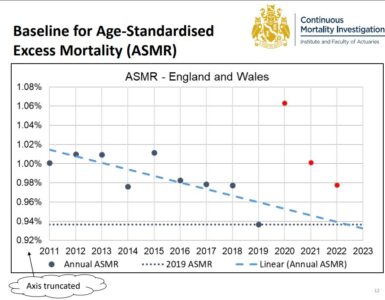EDIT: An update to this blog using newer data is available here: https://covidactuaries.org/2021/07/27/how-many-covid-patients-in-hospital-are-vaccinated-an-update/
Against a backdrop of rising hospital admissions in the presence of the now-dominant Delta variant, we provide regular updates hospitalisations and occupancy in England on Twitter. A common question we’re asked is “what proportion of these people are vaccinated?”
When no-one had been vaccinated, all hospitalisations were of course unvaccinated people. Conversely in a 100% vaccinated population, all hospitalisations would be vaccinated people. A part-vaccinated population with vaccination rates varying by factors such as age requires some analysis.
Useful data showing cases and hospitalisation counts by vaccination status is provided by Public Health England (PHE) as part of their “SARS-CoV-2 variants of concern and variants under investigation in England” technical briefings. These are updated every 2 weeks (although figures from Briefing 17 were carried forward to Briefing 18 because of timing of hospital data releases). The latest available data includes all confirmed Delta cases and emergency attendances up to 21 June 2021.
The graphs below compare the split of cases and hospitalisations in the PHE report with vaccination take-up rates in England as at 31 May 2021. We have used vaccination dose information from the UK Government Coronavirus Dashboard and mid-2020 population estimates. We’ve allowed a 3-week lag to reflect the gradual build-up of immunity after receiving a dose.


For all age groups, the proportion of unvaccinated or recently (first-dose) vaccinated cases and hospitalisations is significantly higher than the proportion of people who are unvaccinated in the general population.
Conversely the proportion of fully vaccinated cases and hospitalisations is significantly lower than the proportion of people who are fully vaccinated, demonstrating that vaccines are protective, albeit not 100% protective.
We can compare the likelihood of hospitalisation in each group to help understand the real-world effectiveness of the vaccines.
- For the under 50s, we can see that 46% of the population is unvaccinated but they make up 87% of admissions. Meanwhile, 21% of the population is fully vaccinated but they make up just 4% of admissions. This tells us that the risk to unvaccinated people under 50 is 11 times higher* than the risk to vaccinated people.
- For those aged 50 plus, we can see that just 5% of the population is unvaccinated but they make up 34% of admissions. Meanwhile, 79% of the population is fully vaccinated but they make up 43% of admissions. This tells us that the risk to unvaccinated people over 50 is 12 times higher* than the risk to vaccinated people.
Another way of thinking about this data set is in terms of the proportion of cases that became in-patient hospitalisations. This analysis was presented in our Friday Report Issue 47 and is reproduced below.

The table shows that, as expected, risk of hospitalisation is much higher for people aged 50 plus, when comparing like-for-like vaccination status.
Encouragingly risk of hospitalisation is lowest for those who received a first dose more than 21 days prior and those who received two doses compared to unvaccinated and recently vaccinated groups.
There are come caveats when looking at this data, including:
- No correction is made for other explanatory factors likely to affect risk of hospitalisation, including increasing age (above / below 50 is very broad age banding), other demographic features and co-morbidities.
- As the emergence of Delta is a recent phenomenon, over half of cases have a specimen date in the 28-day period to 21 June, so the incidence of hospitalisations from these recent cases is subject to further increase.
A pre-print study by Stowe et al covering cases and admissions to 4 June 2021 in England adjusted for age, extremely clinically vulnerable groups, ethnicity and test-week to estimate vaccine efficacy against hospitalisation in the presence of the Delta variant. A single dose of any vaccine was reported to be 75% effective against hospitalisation (CI 57-85%), while two doses were 94% effective (CI 85-98%). These results are consistent with figures reported in other countries.
A study in Ontario, Canada that adjusted for demographic and health features reported that a single dose of Pfizer vaccine is 78% effective against risk of hospitalisation or death (CI 65 to 86%).
An Israeli Ministry of Health study that adjusted for age, sex and test-week found that two doses of the Pfizer vaccine were 93% effective against hospitalisations in June 2021, coinciding with spread of the Delta variant there.
In summary, even in a fully vaccinated population, COVID-19 hospitalisations will not be eliminated because, while the vaccine is highly effective, it is not 100% effective. It is important to allow for the background level of vaccination, age and co-morbidity profile before reaching conclusions. As demonstrated here, the unvaccinated run a much higher risk of hospitalisation – COVID-19 vaccines work!
* The real-world effectiveness calculation used here is (86.8% / 45.8%) / (3.8% / 21.3%) = 10.6 for the under 50s and (33.7% / 5.1%) / (43.4% / 79.1%) = 12.2 for the 50 plus group.















